South Korea is a country where tradition and modern life move together without losing balance. The historical places in South Korea reflect the quiet strength of unforgotten corners of the past, but living spaces where memory and meaning still exist. Palaces stand with pride in the middle of busy cities, and temples continue to welcome prayers on misty hillsides. These places have endured not through preservation alone, but through deep respect. For travellers who wish to understand Korea beyond its skyline, these sites reveal legacy.
Top 10 Historical Places In South Korea
From royal residences to mountain temples in silence, these historical places in South Korea offer a closer look at the soul of the nation:
1. Gyeongbokgung Palace, Seoul

Photo: Frank Schulenburg / Wikimedia Commons
Among the many historical places in South Korea, this one carries a certain stillness, something regal but not distant. Built in 1395, Gyeongbokgung served as the principal seat of power for the Joseon kings. Though severely damaged during foreign invasions, it has been carefully restored to reflect its original splendour. Visitors walking through its courtyards encounter traditional wooden halls, elegant pavilions, and lotus ponds that speak to a life once reserved for royalty. From the intricate paintwork to the mountain views behind Gyeonghoeru Pavilion, every corner holds a sense of purpose and pride.
Timings: 9 AM – 6 PM (closed Tuesdays)
Nearby Attractions: National Palace Museum, Bukchon Hanok Village
2. Changdeokgung Palace And Huwon, Seoul
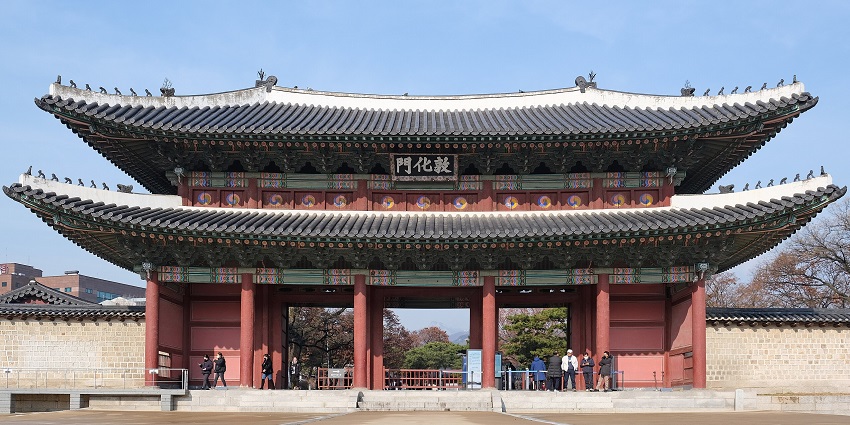
Photo: kallerna / Wikimedia Commons
Tucked into the eastern part of Seoul, Changdeokgung Palace sits not in defiance of nature, but in deep respect for it. Among the many historical places in South Korea, the architecture was shaped by the contours of the land. Built in 1405 during the Joseon dynasty, the palace became a favourite royal residence, especially valued for its balance between structure and scenery. Beyond the main halls and pavilions lies Huwon, the Secret Garden, a space of shaded trails, old trees, calm ponds, and peaceful pavilions. The garden was once closed to all but the royal family and their guests. Today, visitors follow guided paths that lead through centuries of carefully preserved landscape.
Timings: 9 AM – 6 PM (closed Mondays)
Nearby Attractions: Jongmyo Shrine, Insadong
3. Hwaseong Fortress, Suwon

Photo: Lance Vanlewen / Wikimedia Commons
Set against the modern rhythm of Suwon, Hwaseong Fortress curves through hills, gates, and towers with grace. This site earns its place among the most distinctive historical places in South Korea because of its purpose and precision. Built in the late 18th century by King Jeongjo to honour his father it was constructed using both traditional and contemporary techniques. The fortress stretches over five kilometres, offering a path that winds past lookout towers, secret gates, and arched passageways. From the top, the views of the city unfold in every direction.
Timings: 9 AM – 6 PM
Nearby Attractions: Suwon Hwaseong Museum, Paldalmun Gate
4. Seokguram Grotto, Gyeongju
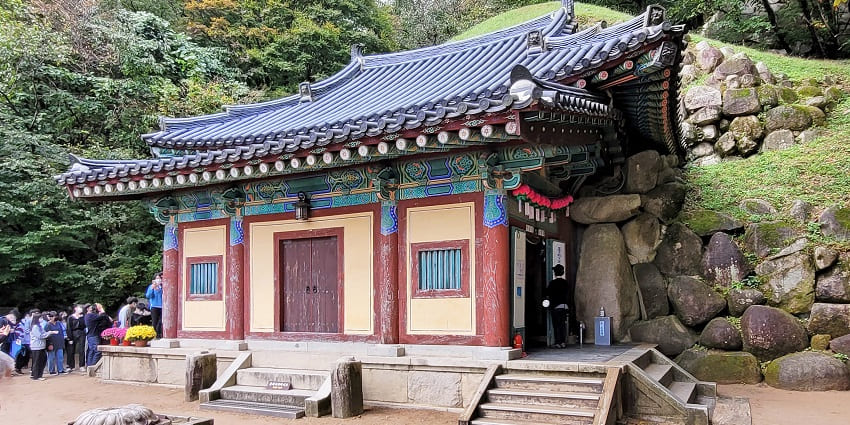
Photo: Bernard Gagnon / Wikimedia Commons
The long, uphill path to Seokguram Grotto is quiet, lined with trees that open slowly to the mountain’s view. This stone temple, carved into the slopes of Mount Toham, stands as one of the historical places in South Korea. Built during the Unified Silla period in the 8th century, the grotto houses a single-seated Buddha. It is surrounded by carefully sculpted guardians and bodhisattvas, each detail shaped with striking clarity. The dome-shaped chamber was constructed with engineering that still holds its original form without mortar. Inside, soft natural light passes through a narrow entrance, falling on the Buddha’s face.
Timings: 7 AM – 6 PM
Nearby Attractions: Bulguksa Temple, Gyeongju Folk Craft Village
5. Bulguksa Temple, Gyeongju
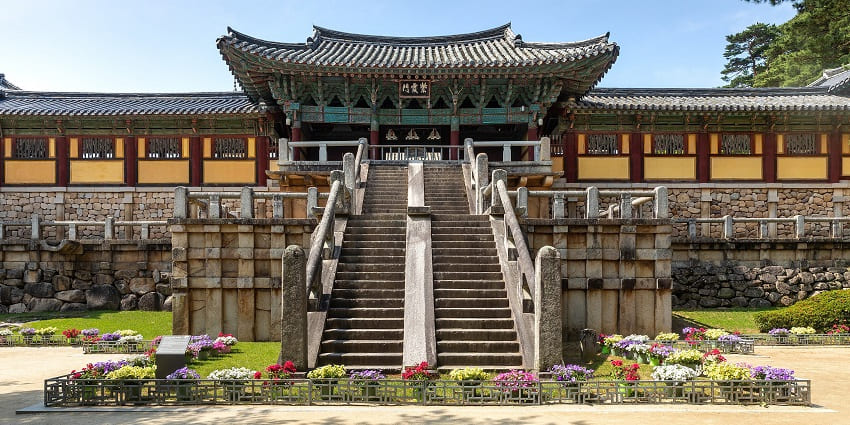
Photo: Basile Morin / Wikimedia Commons
Set against the gentle slopes of Tohamsan, Bulguksa Temple reflects a time when architecture was shaped by belief. It is one of the most revered historical places in South Korea, not only for its age but for the meaning it continues to hold. From the stone staircases to the twin pagodas, Dabotap and Seokgatap, every part of the complex was placed with intention. Though the temple has suffered destruction over centuries, its restoration stays true to the original layout. It is the way time slows down as you pass through the gates, how silence becomes something you admire.
Timings: 7 AM – 5 PM
Nearby Attractions: Seokguram Grotto, Tumuli Park
6. Jongmyo Shrine, Seoul
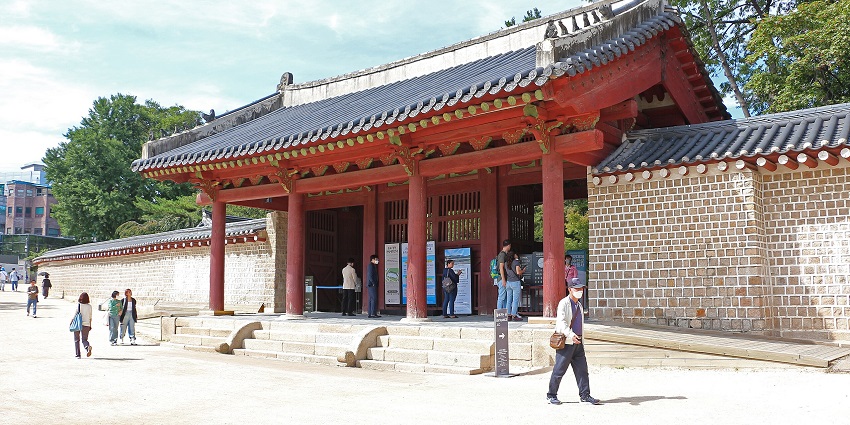
Photo: Bgag / Wikimedia Commons
In a city filled with royal palaces and temples, Jongmyo Shrine feels different. There’s no grandeur to chase here, just quiet paths, long corridors, and a calm that speaks more loudly than ceremony ever could. Jongmyo was built in the 14th century to honour the deceased kings and queens of the Joseon dynasty. Its rituals are still performed today following Confucian principles which reflect centuries of tradition. The stone walkways, aged rooftops, and long wooden halls seem untouched by the pace of the modern world. Each step through its stone walkways, aged rooftops, and long wooden halls is living through remembrance.
Timings: 9 AM – 6 PM (closed Tuesdays)
Nearby Attractions: Changdeokgung Palace, Tapgol Park
7. Haeinsa Temple, Hapcheon
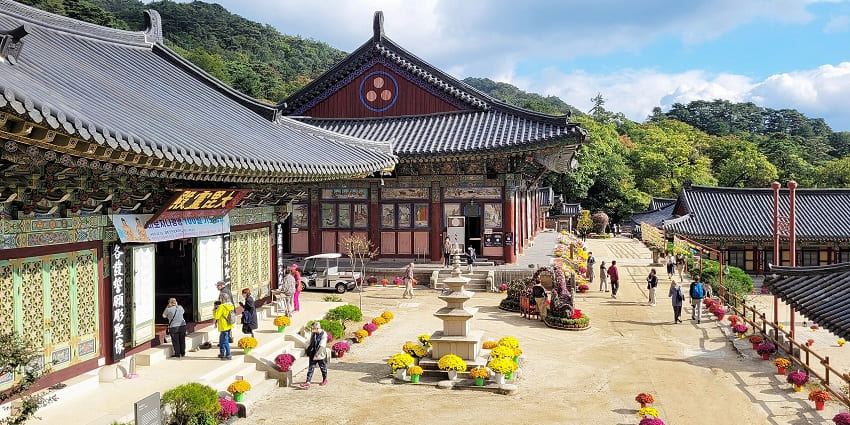
Photo: Bernard Gagnon / Wikimedia Commons
Hidden within the forests of Gayasan, Haeinsa Temple was founded in the early 9th century. As one of the most sacred historical places, Haeinsa houses the Tripitaka Koreana. It has over 80,000 wooden printing blocks carved with Buddhist scriptures. The collection is stored in specially designed halls that date back to the 15th century. Unlike other sites, this temple continues to function as a spiritual centre, where monks carry out rituals with quiet focus. The walk through its courtyards, under the watch of pine-covered slopes, invites a slower pace.
Timings: 8:30 AM – 5:30 PM
Nearby Attractions: Gayasan National Park, Haeinsa Museum
8. Namhansanseong Fortress, Gwangju (Gyeonggi Province)
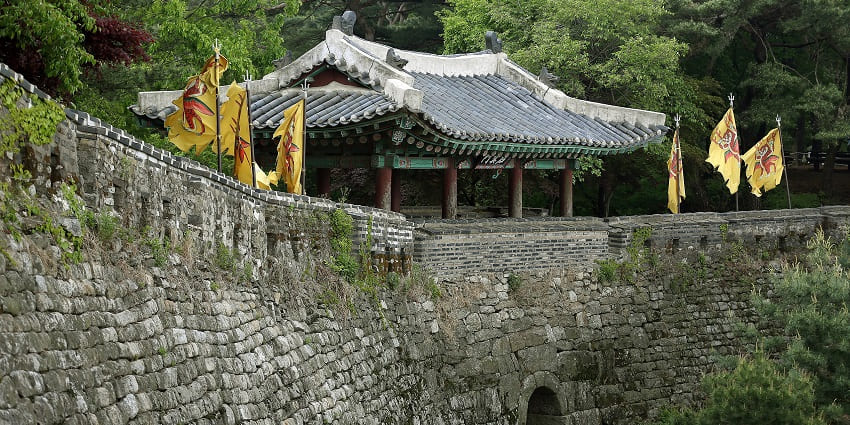
Photo: Republic of Korea / Wikimedia Commons
High above the city edge, where pine trees stretch across ridgelines, Namhansanseong Fortress holds centuries of defence, strategy, and quiet resilience. It belongs among the most remarkable historical places for how seamlessly it blends into the mountains that once protected the capital. First built during the Goguryeo kingdom, this fortress became a final shelter during the Manchu invasion of 1636. Its massive stone walls now form a trail that winds over 12 kilometres, with towers, arched gates, and steep vantage points. The air carries the past, especially around the reconstructed palace and small hillside temples.
Timings: 24*7
Nearby Attractions: Haenggung Palace, hiking trails
9. Gongsanseong Fortress, Gongju
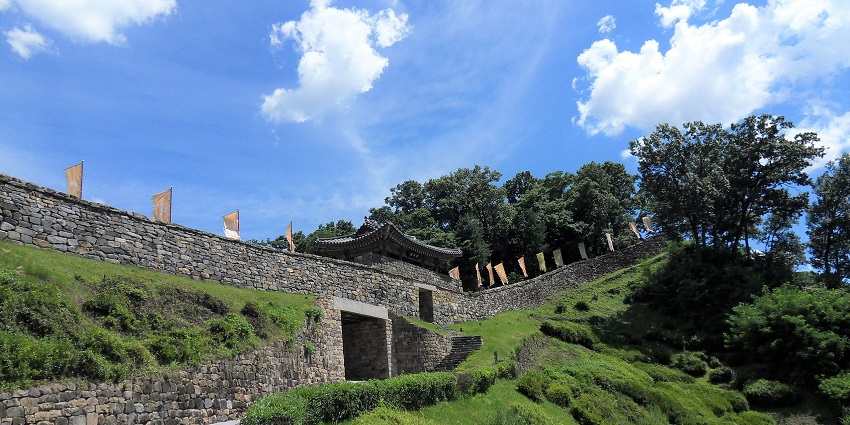
Photo: Ashy Minivet / Wikimedia Commons
The hillside above the Geum River holds more than just stone, it carries the layered history of Gongsanseong Fortress. This fortress dates back to the Baekje Kingdom, once built of earth and later rebuilt in stone during the Joseon period. Its stone walls rise and fall with the mountain’s natural slope, revealing wide views of Gongju and the valley below. Inside the grounds, the royal residences and official buildings point to a time when this hilltop served as a governing centre. Follow the trail, pass through timeworn gates and pavilions rebuilt with care. Gongsanseong carries more than military purposes and stands as a lasting marker of strength, order and legacy.
Timings: 9 AM – 6 PM
Nearby Attractions: Gongju National Museum, Tomb of King Muryeong
10. Donggung Palace And Wolji Pond, Gyeongju
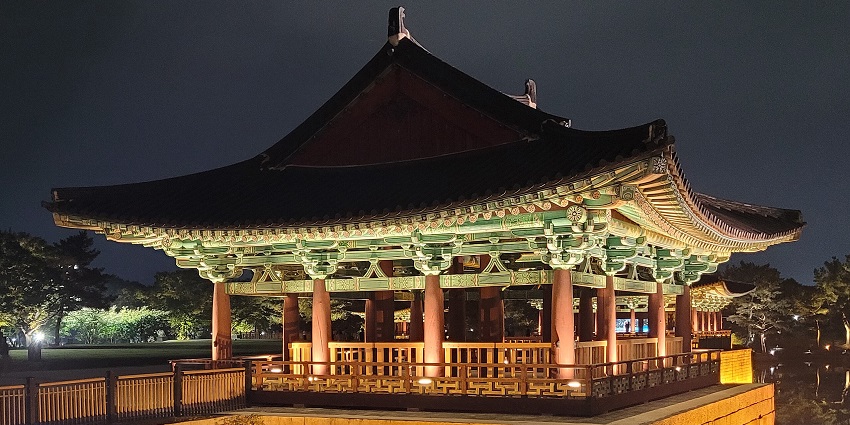
Photo: Bernard Gagnon / Wikimedia Commons
Evening brings out the quiet beauty of Donggung Palace and Wolji Pond. The palace, once used by Silla crown princes for formal banquets, sits beside calm water that mirrors its silhouette in soft gold. Among the many historical places in South Korea, this site stands apart for how closely it ties elegance with nature. Lanterns now line the pathways, and reflections ripple with even the slightest breeze. Archaeological digs have uncovered roof tiles, pottery, and glassware, evidence of a refined royal setting, now displayed in the local museum.
Timings: 9 AM – 10 PM
Nearby Attractions: Gyeongju National Museum, Cheomseongdae Observatory
The historical places in South Korea cover a wide span of dynasties, styles, and settings. These range from palace grounds in Seoul to remote mountain temples and ancient fortress walls. Each site reflects a clear role in Korea’s political, religious, or cultural development. Their layout, location, and design reveal how traditions evolved over time. For travellers planning a route through these regions, TripXL offers a practical way to organise stops. Book your visit with TripXL today.
Cover Photo: Basile Morin / Wikimedia Commons


 WhatsApp
WhatsApp
 Twitter
Twitter









